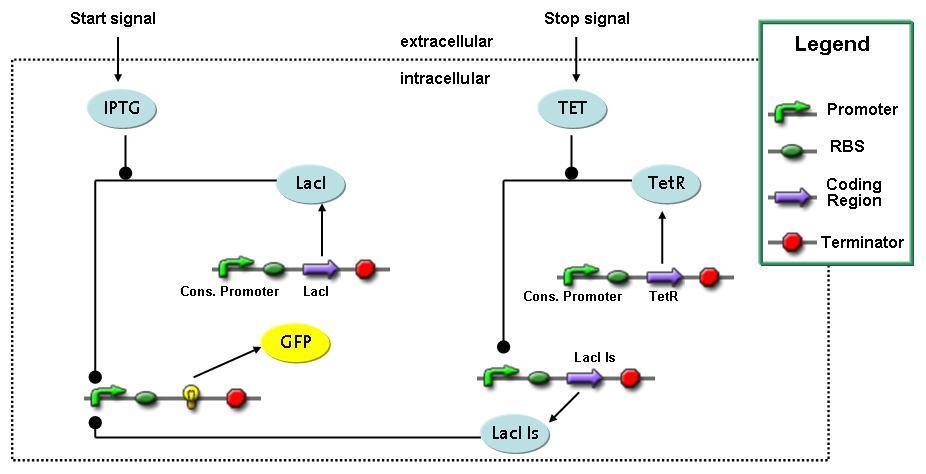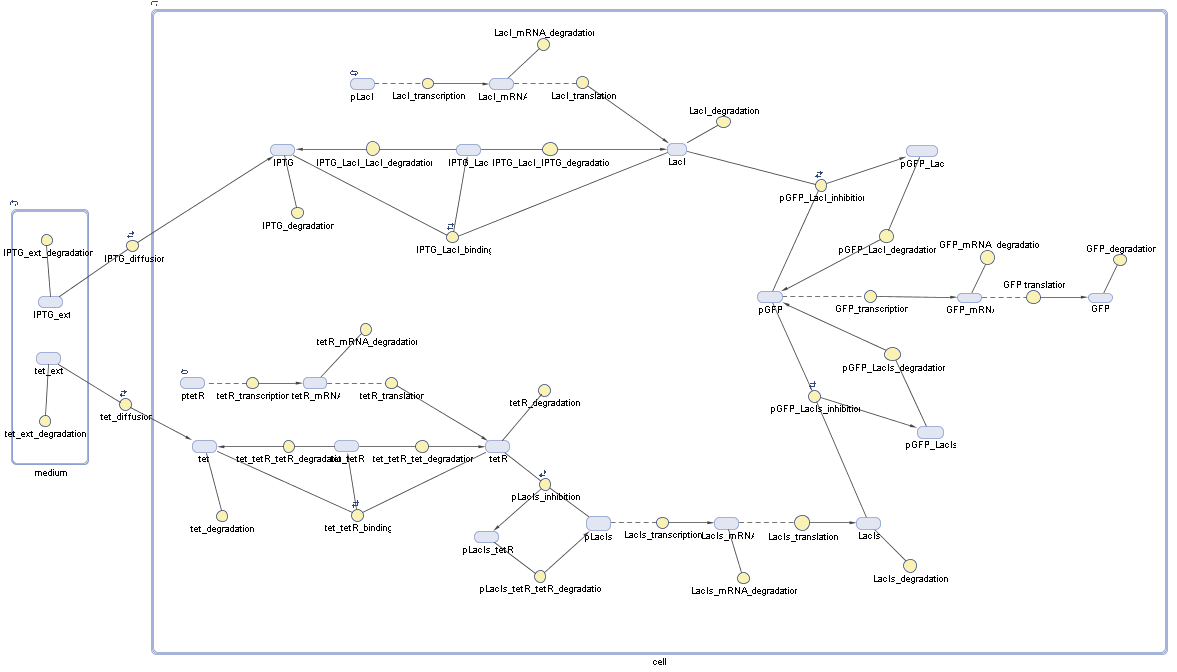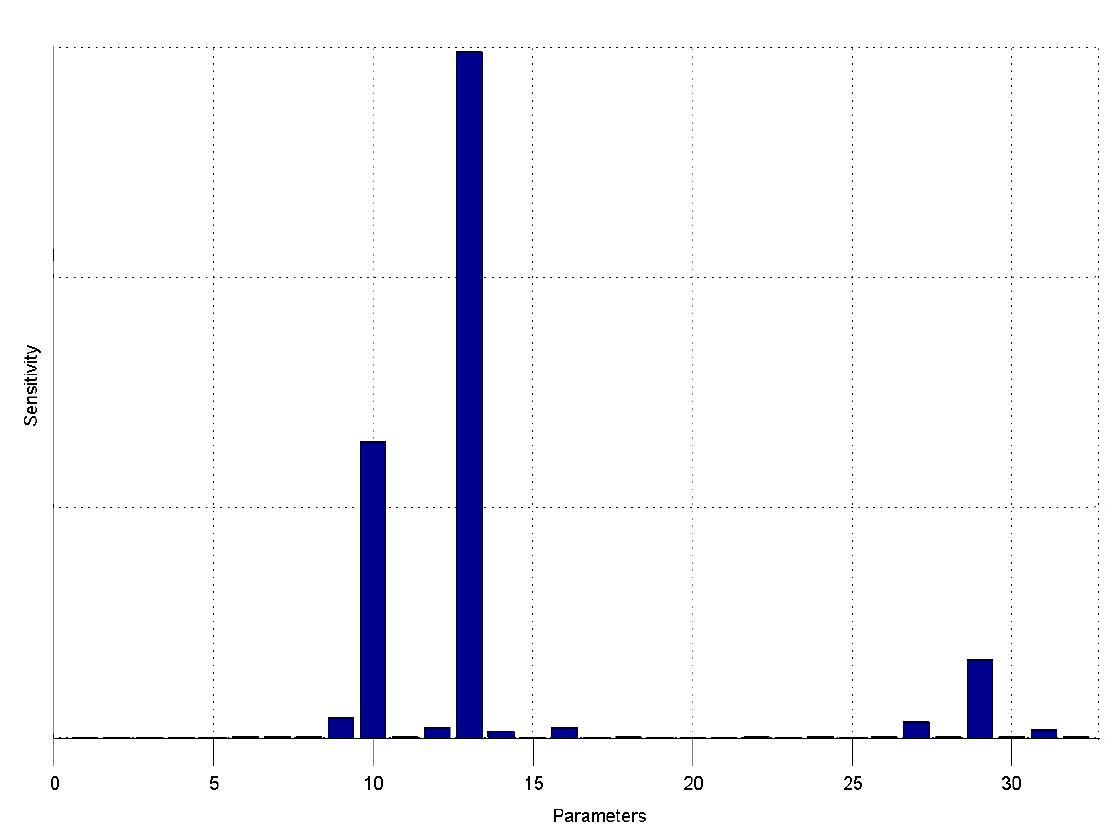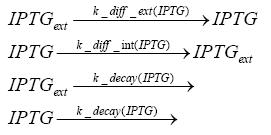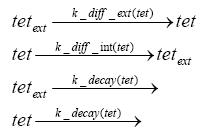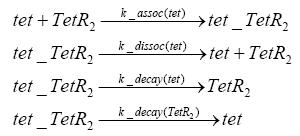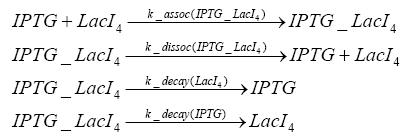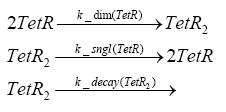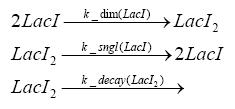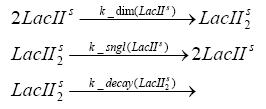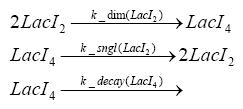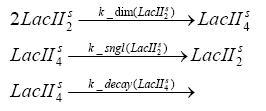Team:ETH Zurich/Modeling/Switch Circuit
From 2008.igem.org
(→Implementation and Simulation) |
m (→binding of LacI and LacIIs to GFP-promotor) |
||
| Line 69: | Line 69: | ||
=== binding of LacI and LacIIs to GFP-promotor === | === binding of LacI and LacIIs to GFP-promotor === | ||
LacI which is constitutively expressed and LacIIs which is under the control of a tet repressor both can bind to the GFP promotor.<br> | LacI which is constitutively expressed and LacIIs which is under the control of a tet repressor both can bind to the GFP promotor.<br> | ||
| - | <html><img src="https://static.igem.org/mediawiki/2008/7/73/Circuit_TetR_PLacIIs.JPG" alt="Grafik" width="30%"></img></html> | + | <html><table><tr><td><img src="https://static.igem.org/mediawiki/2008/7/73/Circuit_TetR_PLacIIs.JPG" alt="Grafik" width="30%"></td><td></img></html> |
[[Image:binding_LacIIs_to_Pgfp.JPG|left width=30%]] | [[Image:binding_LacIIs_to_Pgfp.JPG|left width=30%]] | ||
| - | [[Image:binding_LacI_to_Pgfp.JPG|left]]<br clear="all" > | + | [[Image:binding_LacI_to_Pgfp.JPG|left]] |
| + | <html></td></tr></html> | ||
| + | <br clear="all" > | ||
=== binding of tet to TetR === | === binding of tet to TetR === | ||
Revision as of 14:58, 29 October 2008
Switch CircuitUsing a novel pulsing mechanism consisting of two signals – a start signal that initiates the synthesis of restriction enzymes, and a terminating signal, which switches gene expression off – we are able to delete genome fragments in vivo. To simulate this system we developed, a switch circuit which works (see Switching Curcuit) as follows: Restriction enzyme gene expression is under the control of LacI and can be induced by the addition of IPTG. In order to stop gene expression, the IPTG-sensitive LacI is replaced by IPTG-insensitive LacIS, which shuts restriction enzyme gene expression off again. The synthesis of LacIS is started by the addition of Tetracyclin to the system, which binds to the tet repressor TetR and thus de-represses the expression of the lacIS gene. This circuit is modeled by ca. 40 reactions and is simulated using ODE solver and stochastic simulations. Implementation and SimulationImplementationFor the implementation, different steps having no significant effects on the aspired results have been neglected for the sake of simplicity. In the transcriptions the additional step involving the RNA-Polymerase and in the translations the step involving the ribosomes have not been taken into account. Furthermore, the effects of the dimerization of TetR as well as the impacts of dimerization and tetramerization of LacI and LacIIs have not been considered in the final implementation. This simplified model still comprises more than 20 different species and over 30 kinetic reactions and has been implemented by using the Simbiology Toolbox in MATLAB. To get any useful results form the model, we performed deterministic and stochastic simulations based on the Mass-Action-Kinetics. The stochastic simulations turned out to be computationally very exhaustive but generated no further significant information compared to the deterministic simulations. Simulation ResultsSensitivity AnalysisWe define the sensitivity as the change of the production of the desired fluorescence protein - which is the output of our system - depending on the change of the paramters. The sensitivity analysis shows, that the concentration of the fluorescent protein strongly depends on its decay rate (paramter 13) the decay rate of its mRNA (paramter 10) and of course the transcription and translation rates of the protein (paramters 29 and 27), which is no surprise.
We can also see that the decay rate of LacIIs (paramter 9) and the transcription rate of LacIIs (paramter 31) have an influence on the expression of the fluorescent protein.
Results and DiscussionThe simulations show that our system actually should create a nice pulse-shaped expression of the fluorescent protein (FP). This expression can be started by inducing with IPTG and stopped by subsequent addition of tet into the medium. By tagging the protein it will be degraded much faster by the Clp protease, so that the overall concentration is bounded and, after activating the stop-signal, the remaining proteins disappear quickly. Another fact, our simulations show, is that in order to get one single pulse, the tet-concentration inside the medium must not reach zero before all the IPTG has degraded too. Otherwise, there would still be IPTG in the system inhibiting the binding of LacI to the FP-promotor and leading to an unwanted expression of our protein of interest as the LacIIs degrades. Detailed Modeldiffusion of IPTGIn order to switch on the circuit, we induce with IPTG. When IPTG is added into the medium it diffuses reversibly between the medium and the cells, where it is slowly degraded. In a chemostat extracellular IPTG is washed away. diffusion of tetThe second inducer which is used in our system is tet. This one also diffuses into the cell when it is added into the medium and degrades slowly. binding of TetR to LacIIs-promotorTetR is constitutively expressed and binds to the LacIIs promotor, inhibiting its expression. binding of LacI and LacIIs to GFP-promotorLacI which is constitutively expressed and LacIIs which is under the control of a tet repressor both can bind to the GFP promotor. |
 "
"
